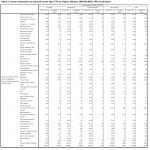The James J. Heaney Institute Presents: A New Study of Religion and Contraceptive Use
In 2011, the Guttmacher Institute, the research arm of Planned Parenthood, published a routine paper analyzing religion and contraception use. During the past week, that paper has caused quite the little internet brouhaha, in light of the Obama Administration's new anti-Catholic (it isn't controversial to call it that anymore, is it?) contraception mandate. The Guttmacher Institute has been put on the defensive, while Nancy Pelosi and establishment Democrats and media organizations have mutated and wildly exaggerated the Guttmacher Institute's already controversial findings. The Guttmacher numbers have been criticized for the sample populations they chose, the transparency of their computations, and for failing to discriminate within various demographics (for example, practicing vs. non-practicing Catholics, married vs. unmarried non-virgins, etc.)
We have long been curious about Catholics and contraception use, and this controversy finally nudged us into action. We decided to address the Catholic blogosphere's concerns over the Guttmacher study the simplest way we could think of: we did our own study. The data AGI analyzed were from a major government survey, not a private polling firm, so the entire dataset was available for download on the website of the Centers for Disease Control. We grabbed it, spent a few days setting up and configuring some statistics software, then headed to the James J. Heaney Institute's well-equipped computer lab for a week to pore over the numbers.
The full study is attached at the bottom of this post, and I strongly encourage you all to read it. Here are some of what I view as the key tables in the study (click to view full-size):

Some of our key findings:
Among all practicing Catholic women ages 15-44, almost exactly half are living in accordance with Church teaching on sexuality, chastity, and marriage, while the other half (49.9%) are using methods of artificial birth control.
Since the male and female 15-44 cohorts combined represent 45% of the American population, we can further estimate, ceteris paribus, that about 77% of the people in the Catholic pews every Sunday are living (or trying to live) in accordance with Church teaching on human sexuality.
14% of practicing Catholics age 17 or older have never used any method of artificial birth control. (17 is the average age of first sexual intercourse for American women, according to the Guttmacher Institute.) The corresponding figure for non-religious women 17 or older is half that, at 7%.
4% of faithful, practicing Catholic wives, ages 15-44, who are not pregnant, trying to get pregnant, or postpartum, rely on natural family planning to regulate the spacing of their childbearing. This is four times the rate of NFP reliance in the general population, and fifteen times the rate of NFP reliance among non-religious wives. 11% of faithful, practicing Catholics wives who are not pregnant, postpartum, or actively seeking pregnancy are also not actively avoiding it (no method), and a total of 17% meet Catholic standards for "openness to life." The corresponding figure among the general population is 10%, which is nearly identical to the figure for non-religious wives.
There is a strong correlation between Mass attendance and contraceptive behavior among Catholics. Practicing Catholics are significantly more likely to obey Catholic teachings on sexuality than the general population (which is not bound by them). While sample sizes for highly devout Catholics (those who attend Mass more than once each week) were too small to provide firm figures, it was clear that they, in turn, were significantly more likely to embrace Pope John Paul II's "Theology of the Body" than their every-Sunday counterparts.
Interestingly, lapsed Catholics (those not attending Mass weekly) are, in many cases, less likely to obey Church teachings than the non-Catholic general population. This dragged down Catholic results throughout the original Guttmacher study, which either did not differentiate on Mass attendance or included all who attended Mass more than once a month in their analyses of particularly devout Catholics.
The full study is here (PDF format):
"Countering Countering Conventional Wisdom" - The James J. Heaney Institute
A minor update to the study was released on 29 Feb 2012 at 2035 GMT. No findings were changed, but some typos were corrected, tables were slightly reformatted, and methodological issues were clarified. (The study as originally released can be found here.)
Thank you for choosing De Civitate and the James J. Heaney Institute as your source for information on religion and contraception use. Why not bookmark us, or subscribe to our RSS feed on the right side of the screen, while we're on your mind?
FRIENDLY DISCLAIMER: Although we have some statistics training, we are not a statistician. We are a computer scientist. We just really think statistics are the bee's knees.


